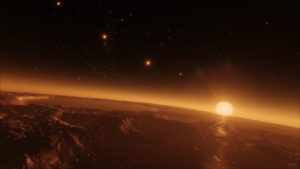 In 1992, scientists discovered what they call “Exoplanets” revolving around other stars in our galaxy. Discovering these giant planets opened the door for more discoveries. The 2009 launch of the Kepler Space Telescope is giving scientists a lot of new information about the nature of life. The Kepler Space Telescopes mission is to find these exoplanets so scientists can study what’s going on in these foreign worlds. And what scientists are discovering is going to change the way we look at our galaxy.
In 1992, scientists discovered what they call “Exoplanets” revolving around other stars in our galaxy. Discovering these giant planets opened the door for more discoveries. The 2009 launch of the Kepler Space Telescope is giving scientists a lot of new information about the nature of life. The Kepler Space Telescopes mission is to find these exoplanets so scientists can study what’s going on in these foreign worlds. And what scientists are discovering is going to change the way we look at our galaxy.
According to new data from the Kepler Telescope, exoplanets that are 2.5 times the radius of Earth contain a lot of water. Scientists now know there are 4,000 of these giant planets in our galaxy. Some of them are 1.5 times bigger than Earth, and others are 2.5 times bigger. The planets that are 1.5 times bigger are rocky planets, and the larger planets are water worlds. Scientists also discovered that the big planets have a surface temperature between 200 to 500 degrees Celsius. Scientists also believe the atmosphere is mostly water vapor with a layer of water underneath the surface of these massive planets.
According to Harvard University lead researcher Dr. Li Zeng, 35 percent of these massive planets contain a lot of water. Dr. Li Zeng believes the new TESS (Transiting Exoplanet Survey Satellite) mission will discover more of these water-rich planets. And the James Webb Space Telescope, which is the next generation is space telescopes, will be able to characterize the atmosphere in these remote worlds, according to Zeng.
The old scientific theories, life needs water to survive. But if there is life on some or all of these planets it may not be the same as like on Earth. New scientific theories are changing the way scientists look at life because the scientists now know some forms of life don’t need water to thrive. According to Cornell University scientists, a methane-based organism may thrive on Titan. Titan is Saturn’s moon. Scientists call this life-form azotosome.
We tend to look at life the way we perceive it, but other planets may have their own version of life. And those life forms may be just as conscious of their reality as we are, according to some scientists. If there is life, then there is consciousness on these planets. And that means we have something in common with these unusual forms of life. Not all scientists believe that, but no matter what life looks like it will be a form of consciousness, according to Dr. Zeng.





